The Short-tailed Albatross (Phoebastria albatrus) is a remarkable seabird renowned for its striking appearance and fascinating life history.
With its majestic wingspan and distinctive yellow-orange bill, this species commands attention as one of the world’s most giant and iconic albatrosses.
Once teetering on the brink of extinction due to historical exploitation and habitat destruction, concerted conservation efforts have led to a gradual recovery of populations in recent years.
Breeding primarily on remote islands such as Torishima and the Senkaku Islands in the North Pacific Ocean, the Short-tailed Albatross embodies resilience and symbolizes hope for the conservation of marine biodiversity.
Despite facing threats such as habitat degradation and fisheries bycatch, this magnificent bird inspires awe and admiration among researchers, conservationists, and nature enthusiasts alike.
How to Identify Short-tailed Albatross
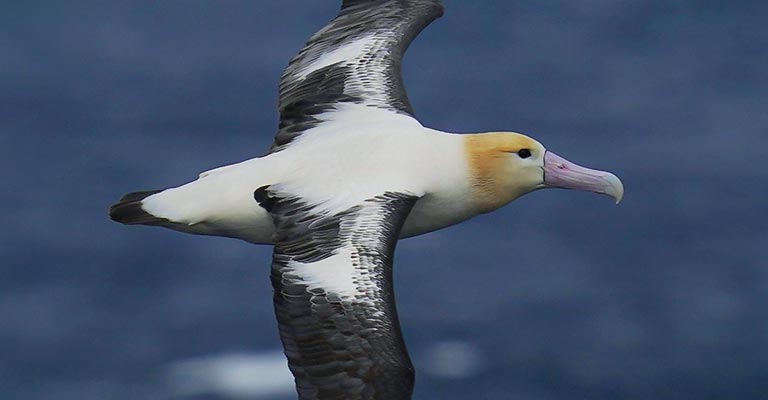
Identifying the Short-tailed Albatross (Phoebastria albatrus) can be an exciting challenge due to its distinctive features and striking appearance. Here are eight key points to consider when identifying this specific bird:
Size and Shape
The Short-tailed Albatross is one of the largest albatross species, with a wingspan reaching up to 7.9 feet (2.4 meters). It has a robust body and broad wings, giving it a commanding presence in flight.
Plumage
Adult Short-tailed Albatrosses have striking white plumage with contrasting black markings on their wings and back.
Juveniles have a more mottled appearance, with darker feathers on their upperparts gradually giving way to white as they mature.
Yellow-Orange Bill
One of the most distinctive features of the Short-Tailed Albatross is its large, bright yellow-orange bill. This bill stands out prominently against the bird’s white plumage and is particularly striking in breeding adults.
Dark Eye Patch
Short-tailed Albatrosses have a dark eye patch contrasting with their pale facial plumage. This feature helps differentiate them from other albatross species, such as the Laysan Albatross, which lack this distinctive marking.
Behavior
Short-tailed Albatrosses are known for their graceful and effortless flight, often soaring low over the ocean waves with minimal wing flapping.
They may also exhibit dynamic soaring behavior, using wind currents to cover long distances with minimal energy expenditure.
Breeding Range
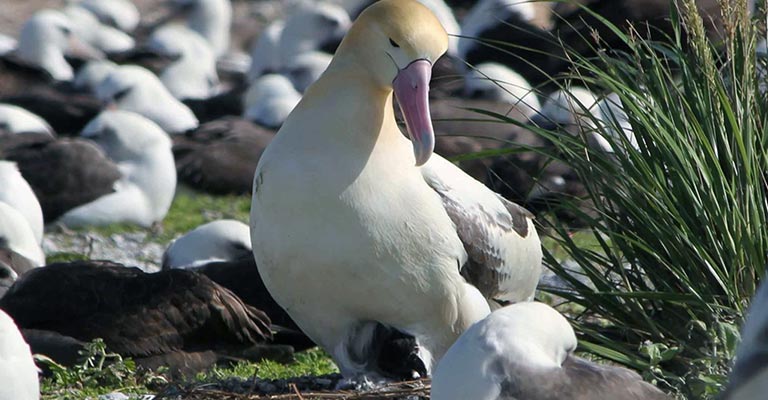
Short-tailed Albatrosses breed primarily on remote islands in the North Pacific Ocean, including Torishima and the Senkaku Islands. Their breeding colonies are often on cliffs or rocky outcrops near the ocean.
Vocalizations
While not as distinctive as physical features, the vocalizations of Short-tailed Albatrosses can also aid in identification. They produce a variety of calls, including honking and braying sounds, particularly during courtship and nesting periods.
Conservation Status
Due to historical exploitation and habitat destruction, Short-tailed Albatross populations were once critically endangered.
Conservation efforts have led to a gradual recovery of populations in recent years, but they remain vulnerable to threats such as habitat loss, pollution, and fisheries bycatch.
Identifying the Short-tailed Albatross requires careful observation of its size, plumage, bill color, behavior, breeding range, vocalizations, and conservation status.
By considering these key points, birdwatchers and enthusiasts can recognize and appreciate the unique beauty and significance.
Taxonomy of Short-tailed Albatross
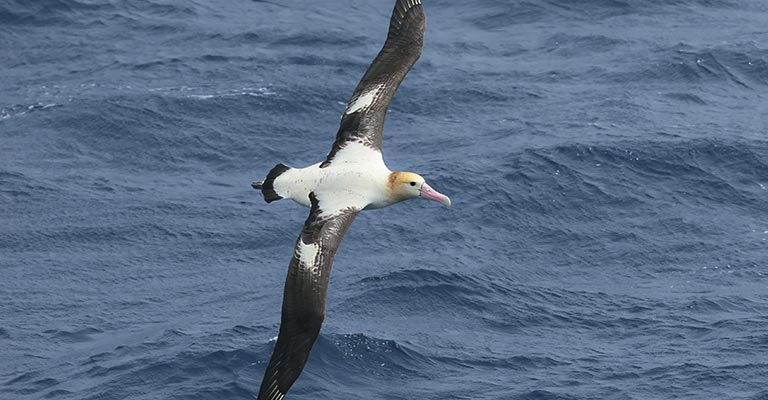
Below is the table detailing the taxonomy of the Short-tailed Albatross:
| Taxonomic Rank | Classification |
| Domain | Eukaryota |
| Kingdom | Animalia |
| Phylum | Chordata |
| Class | Aves |
| Order | Phaethontiformes |
| Family | Diomedeidae |
| Genus | Phoebastria |
| Species | P. albatrus |
The Short-tailed Albatross (Phoebastria albatrus) belongs to the family Diomedeidae within the order Procellariiformes. This family comprises large seabirds known for their impressive wingspans and oceanic lifestyles.
Within the genus Phoebastria, the Short-tailed Albatross is distinguished by its size, distinctive yellow-orange bill, and white plumage with black markings.
It is closely related to other albatross species, including the Laysan Albatross and Black-footed Albatross.
The Short-tailed Albatross is further classified into several subspecies based on geographical distribution. Its taxonomy reflects its evolutionary relationships and ecological niche as a pelagic seabird of the North Pacific Ocean.
Hunting Habit of Short-tailed Albatross
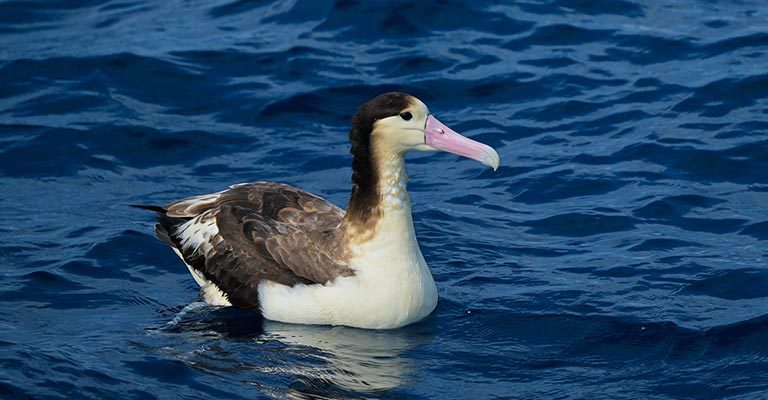
The hunting habits of the Short-tailed Albatross (Phoebastria albatrus) primarily focus on foraging for prey over the vast expanses of the open ocean.
These seabirds are highly skilled hunters, relying on their keen eyesight and soaring abilities to locate and capture food efficiently.
Short-tailed Albatrosses feed on a diet of fish, squid, and crustaceans, which they capture by plunge-diving or surface-seizing while in flight.
They often forage in areas of upwelling, where nutrient-rich waters attract prey species. Short-tailed Albatrosses are opportunistic feeders and may scavenge on carrion or offal from fishing vessels.
Their hunting behavior is adapted to the dynamic and unpredictable nature of the marine environment, allowing them to exploit food resources effectively and sustainably as they navigate the vast oceanic realm.
Short-tailed Albatross Life History
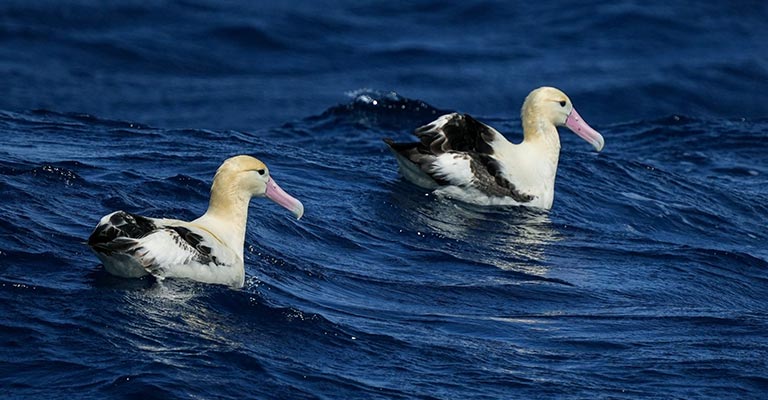
The Short-tailed Albatross (Phoebastria albatrus) stands as a symbol of resilience and conservation efforts, with a fascinating life history intricately woven into the fabric of the North Pacific Ocean.
From its foraging habits to breeding behavior, this majestic seabird embodies the delicate balance between adaptation and vulnerability in the face of human-induced threats.
Food
Short-tailed Albatrosses primarily feed on a diet of fish, squid, and crustaceans, often foraging in areas of upwelling where nutrient-rich waters attract prey species.
They are opportunistic feeders and may also scavenge on carrion or offal from fishing vessels.
Habitat
Short-tailed Albatrosses inhabit the open ocean of the North Pacific, with breeding colonies located on remote islands such as Torishima and the Senkaku Islands.
They spend most of their lives at sea, only returning to land for breeding and nesting.
Range Map
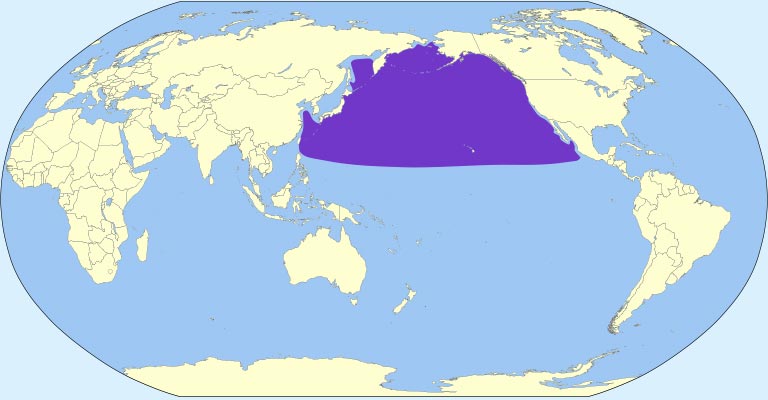
Short-tailed Albatrosses have a restricted breeding range, with colonies primarily in the northwest Pacific Ocean.
Range maps illustrate the distribution of breeding colonies and foraging grounds, highlighting critical areas for conservation efforts.
Nesting
Short-tailed Albatrosses construct simple grass, vegetation, or soil nests, often on cliffs or rocky outcrops near the ocean. Nesting colonies are located on remote islands to minimize disturbance from terrestrial predators.
| Nesting Details | Measurement/Fact |
| Clutch Size | Usually 1 egg |
| Number of Broods | Typically 1 per breeding season |
| Egg Length | Approximately 10-12 cm |
| Egg Width | Approximately 6-8 cm |
| Incubation Period | Around 2 months |
| Nestling Period | Approximately 5-6 months |
| Egg Description | Creamy white with variable markings such as speckles or spots |
| Nest Construction | Simple nest made of grass, vegetation, or soil, often on steep cliffs or rocky outcrops near the ocean |
| Incubation Behavior | Both parents take turns incubating the egg, sharing duties equally |
| Nest Site | Located on remote islands such as Torishima and the Senkaku Islands, away from terrestrial predators |
Breeding
Breeding behavior in Short-tailed Albatrosses involves elaborate courtship displays, with pairs forming long-term bonds. Incubation and chick-rearing duties are shared between parents, with chicks fledging after several months.
Diseases
Short-tailed Albatross populations are susceptible to various diseases, including avian pox and aspergillosis. These diseases can have significant impacts on individual birds and breeding colonies.
Treatment
Treatment of Short-tailed Albatross diseases often involves veterinary care provided by conservation organizations and research institutions.
Interventions may include medication administration, wound treatment, and rehabilitation efforts for affected individuals.
Conservation
Short-tailed Albatrosses face numerous conservation challenges, including habitat loss, pollution, and fisheries bycatch.
Conservation efforts focus on mitigating these threats through measures such as habitat protection, bycatch reduction technologies, and international agreements to safeguard breeding colonies and foraging grounds.
10 Behavioral Habits of Short-tailed Albatross
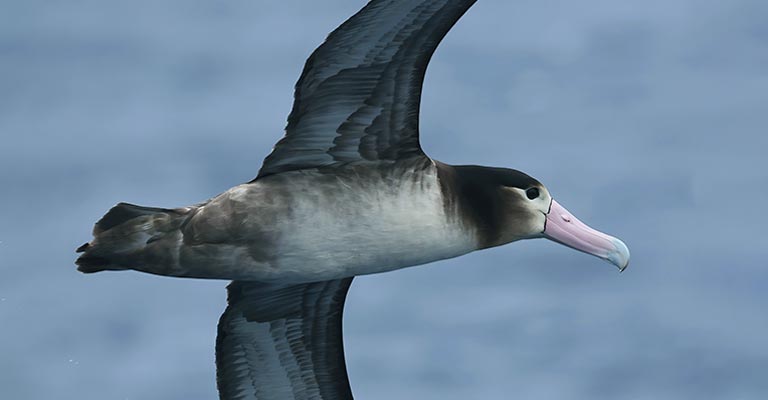
The Short-tailed Albatross (Phoebastria albatrus) exhibits a fascinating array of behavioral habits that reflect its adaptation to life in the open ocean.
From foraging techniques to courtship displays, these behaviors provide insight into this magnificent seabird species’ unique ecology and social dynamics.
Dynamic Soaring
Short-tailed Albatrosses are adept at dynamic soaring, a flying technique that uses wind gradients to gain energy and travel long distances with minimal effort.
This efficient method allows them to cover vast expanses of the ocean while conserving energy.
Foraging
Short-tailed Albatrosses often rely on surface-seizing or plunge-diving techniques to capture prey such as fish, squid, and crustaceans when foraging for food.
They are opportunistic feeders and may also scavenge on carrion or offal from fishing vessels.
Colonial Nesting
Short-tailed Albatrosses typically nest in large colonies on remote islands, constructing simple grass, vegetation, or soil nests.
These colonies protect from terrestrial predators and facilitate social interactions among breeding pairs.
Courtship Displays
During the breeding season, Short-tailed Albatrosses engage in elaborate courtship displays to attract mates and reinforce pair bonds. These displays may include synchronized dances, bill-clacking, and aerial acrobatics.
Long-term Monogamy
Mated pairs of Short-tailed Albatrosses often form long-term monogamous relationships, returning to the same nesting sites year after year. This fidelity to breeding colonies and partners contributes to the stability of their populations.
Parental Care
Both parents share incubation and chick-rearing duties, taking turns to care for the egg and feed the nestling. This cooperative behavior helps ensure the survival of offspring in the challenging marine environment.
Vocalizations
Short-tailed Albatrosses produce a variety of vocalizations, including honking and braying sounds, particularly during courtship and nesting periods. These vocalizations play a crucial role in mate attraction and territorial defense.
Territorial Behavior
Short-tailed Albatrosses may exhibit territorial behavior, particularly during the high competition for nesting sites and mates during the breeding season. Aggressive displays and vocalizations are used to establish and defend territories.
Migration
Short-tailed Albatrosses are highly migratory birds, undertaking long-distance flights between breeding and foraging grounds. They may travel thousands of miles over the open ocean, guided by celestial cues and oceanic currents.
Conservation Response
In response to conservation efforts, Short-tailed Albatross populations have shown signs of recovery in recent years, with increased breeding success and expanding breeding colonies.
These positive trends highlight the resilience of this species and the importance of ongoing conservation initiatives to protect their habitat and mitigate threats.
Wrapping Up
The Short-tailed Albatross (Phoebastria albatrus) stands as a testament to the power of conservation efforts and the resilience of nature.
Through its remarkable behavioral habits, from dynamic soaring to long-term monogamy, this majestic seabird embodies the intricate balance between adaptation and vulnerability in the marine environment.
While facing ongoing threats such as habitat loss and pollution, the Short-tailed Albatross has shown signs of recovery thanks to dedicated conservation initiatives.
By protecting their nesting sites, mitigating human impacts, and raising awareness about their importance, we can ensure a brighter future for this iconic species and their delicate ecosystems.